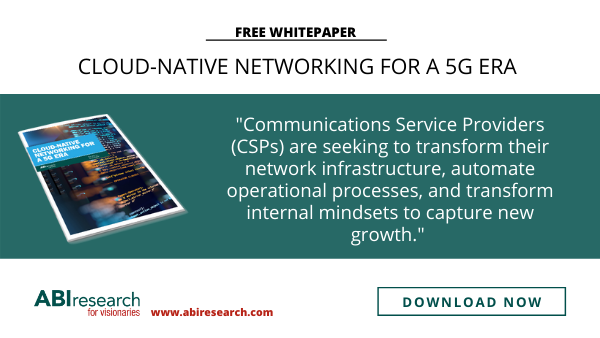5G and Cloud-Native networking Market Overview
Based on findings from a recently commissioned Cloud-Native Networking for a 5G Era report, Communications Service Providers (CSPs) are seeking to transform their network infrastructure, automate operational processes, and transform internal mindsets to capture new growth. The transformation is being driven, in part, by a growth of user data demand, a massive increase in connected devices, an overly complex network, and new Business-to-Business (B2B) revenue growth increasingly tied to 5G adoption. A question of significance for CSPs is how to embed a degree of agility in networks and scale up the emerging enterprise use cases in a way that is sufficiently impactful and not disruptive. This is particularly important for new 5G-centric use cases (e.g., network slicing and 5G private networks) that will almost certainly consist of network elements and services that traverse different technology domains.
CSPs are asking three questions before they adopt a new solution based on cloud-native computing principles:
- Does it help change existing processes?
- Does it change workflows?
- Does the solution (and the vendor providing it) help them acquire the necessary human capital that will be key for an internal “change” toward global software-centric networks?
Such changes will almost certainly be propelled by CSPs’ ability to achieve the right mix of telecoms, agile DevOps methodologies, big data, and analytics expertise in shaping new services. A nimble way of transacting business will be a key aspect for the industry’s push into alternative enterprise revenue streams. This constitutes a horizontal play among CSPs, solution providers, and end verticals to create new value based on use cases that leverage high-capacity and scalable networks.
The Need for Disaggregation in a 5G Era
At its foundation, the industry is geared toward “naturally vertical” mass-market, country-specific consumer services, where the commercial modus operandi revolves around Average Revenue per User (ARPU), bits, and units. Going forward, new and sustained commercial growth will come from E2E “naturally horizontal” platforms that interface with other programs where the value, in part, is providing a stable, standard interface. An inherently software-centric network, such as 5G, is almost certain to supplant the verticalized, siloed operations of today, but on the condition that there is wider ecosystem openness and disaggregation.
5G networks will be a starting point for new “horizontal” growth forays into enterprise verticals. Increasingly, the ability to think horizontally by connecting disparate and disaggregated tools using a common platform will be a priority for CSPs. Furthermore, there is widespread agreement in the industry that favors multi-vendor stacks for 5G networks as opposed to whole-stack integrations from a single vendor. Regardless of which deployment model prevails, in order to reap the full benefits of cloud-native features, full immersion of cloud-native technologies into a rigid telco framework must be avoided.
E2E Orchestration from 5G Core to Edge Cloud and Public Cloud
A single-layer solution in isolation, whether it is at the resource or service layers, will not yield optimum results in 5G networks expected to go beyond consumer services by catering to multiple enterprise use cases. Increasingly, CSPs are recognizing the need for E2E multi-layered orchestration that can provide the agility to quickly compose assets into new products and services in reaction to market needs. Vendors should replace manual processes or scripting with DevOps and programmable network architectures, so that on-demand services requested by the business are readily available. Furthermore, programmable networks, underpinned by merchant silicon, SDN, and cloud-native solutions, introduce disaggregated network functions that necessitate control over two dimensions:
- The orchestration and management of NFs, a virtualized version derived from PNFs
- The management of the virtualization aspect of the network function
An initial requirement for E2E orchestration in 5G networks is full integration of hybrid physical/ virtual environments and network functions, with an eventual full migration to a cloud-native network cloud.
The Rise of An Application-Aware Network
An “application-aware network” is a term often associated with a “composable” enterprise, a company where open APIs, data analytics, mobile, and the cloud blend to provide efficiency and lower-cost processes. Similarly, an application-aware network in telecoms marks a departure from the linear processes of old models like Service-Oriented Architecture (SOA) to promote an API-led approach where the workflows are more dynamic and diverse. The key pillar of an application-aware network is reuse, or infrastructure immutability propelled by a disaggregated network cloud and cloud-native functions (CNFs).
An application-aware network should be underpinned by a building block that encapsulates three distinct components:
- Open APIs on open market hardware
- Intelligent connectivity
- Multi-layered, multi-domain vertical and horizontal orchestration
These pillars serve as a springboard for disaggregated open-model networking that is emerging in the market.
Concluding Recommendations
Data-heavy applications (e.g., gaming, Virtual Reality /Augmented Reality) now constitute approximately 70% of the traffic. Furthermore, with 42 million cloud gaming users estimated by 2024, traffic flowing through 5G and fixed networks is expected to increase exponentially. Carrier-class networking solutions that are built for any scale and can be provisioned on-demand to handle network bursts (like COVID-19) are expected to serve as the foundational pillar for CSPs to pursue new commercial forays and achieving operational efficiencies.
Some CSPs are opting for greenfield network cloud deployments with the idea of subsequently rolling it out across the wider footprint. This is typically the case for CSPs who lack “legacy” deployments or for those who have resources in place to trial new technology alongside existing operations. Other CSPs, who represent the bulk of the market, continue to leverage existing expertise from large equipment vendors, but are also introducing “added value” from disruptor vendors for carrier-class and “cloud-friendly” network clouds.

